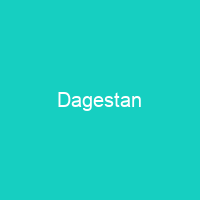Dagestan is a republic of Russia situated on the Caspian Sea. It is located north of the Greater Caucasus, and is a part of the North Caucasian Federal District. Makhachkala is the capital and largest city; other chief cities are Derbent, Kizlyar, Izberbash, Kaspiysk and Buynaksk.
About Dagestan in brief

The word Dagesta is of Turkish and Persian origin. The Turkish word dağ means’mountain’ and the Persian suffix -stan means ‘land’ Some areas of Dagestsan were known as Lezgistan, Avaria and Tarkov at various times. In the first few centuries AD, Caucasian Albania became a vassal and eventually subordinate to the Parthian Empire. With the advent of the Sassanian Empire, it became a satrapy within the vast domains of the empire. In later antiquity, it was a few times fought over by the Roman Empire and the Sassanid Persians as the former sought to contest the latter’s rule over the region, without success. In 664, the Persians were succeeded by the Khazars. By the 15th century, Christianity had died away, leaving a church at Derbent as the sole monument to its existence. As the Mongolian authority eroded, it gradually penetrated steadily into the highlands where it eventually adopted in urban centers, such as Samandar and Kubachi where it was adopted in Islam. In 913, Islam was adopted as the religion by the people of Derbent. In 10th-century, the city became a bastion of civilization, followed by the Caucasian Avar civilization, with its bastion followed by Kubachi in the 12th century. In 13th century the city was overrun by the Huns, who can be traced over many centuries.
You want to know more about Dagestan?
This page is based on the article Dagestan published in Wikipedia (as of Dec. 04, 2020) and was automatically summarized using artificial intelligence.







